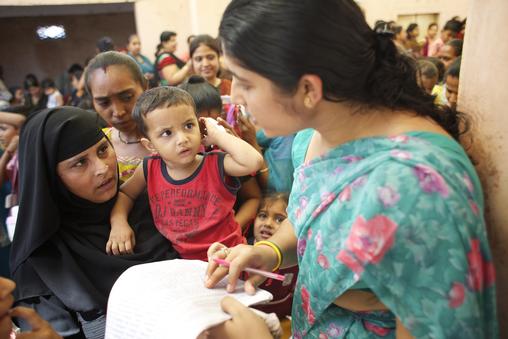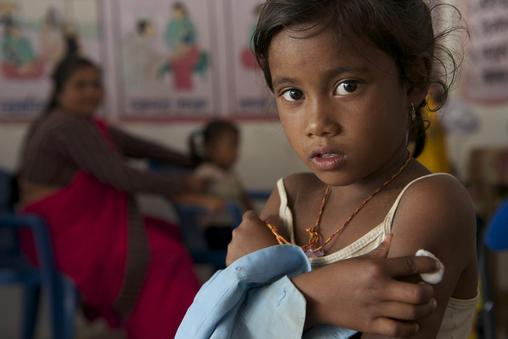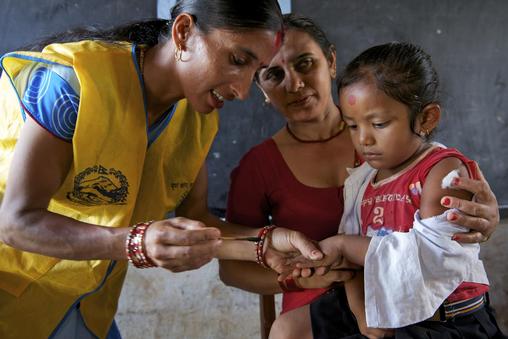Vaccination and Vigilance are Keys to Protecting People from Measles, No Matter Where They Live

SIAs are targeting all children aged 9 months to 10 years in 14 states; more than 20 per cent of infants in those states have never been vaccinated. An immunization registration drive in a neighborhood of Ahmedabad. Photo Credit: UNICEF
Thanks to an effective vaccine and determination, measles has all but been vanquished in the United States while in other parts of the world, the vaccine has saved 20.4 million lives over the last 16 years.
And while measles still inflicts an unacceptable toll, 2016 marked the first time that deaths from the disease fell below 100,000 worldwide.
On the surface all of that seems impressive, if not hopeful. The real picture, however, is more complicated and less congratulatory.
While measles and rubella have largely been removed as a threat to people’s health in the developed world, these preventable diseases remain an all-too-deadly reality in far too many places.
One reason is the remaining gap in the availability of the highly effective vaccines. Globally, the percentage of children receiving the first dose of measles vaccine has remained at 85 percent since 2009. Worse still, only 64 percent of children receive both of the recommended doses of measles vaccine. Only 47 percent of children are currently receiving rubella vaccine. Worldwide, over 20 million children remain unprotected from measles because they did not receive measles vaccine, even though the vaccine costs less than $2 a child.
While combatting measles is often overshadowed by other public health crises, there is a strong, unified and determined effort underway to close the vaccination gap and to protect all people, and especially children, from measles and rubella no matter where they live.

Supplementary Immunization Activities (SIAs) that began in 2010 are aiming to vaccinate some 134 million Indian children against measles by the end of June 2013. Girls await inoculation at their school in Ahmedabad, Gujarat. Photo Credit: UNICEF
The encouraging news is, the need is recognized and the commitment is clear and on-the-record. All 194 nations that are members of the World Health Organization have officially declared their support and participation in the effort to eliminate measles once and for all.
And while work remains, there have been achievements. One of the most notable came in 2016 when every nation in the Region of the Americas stopped endemic transmission and the region as a whole became the first region to be declared free of endemic measles. That milestone, along with a similar declaration in 2015 for rubella, made the Americas the first region to be free of both diseases.
CDC and its experts, including those from the Global Immunization Division, have been part of the effort from the start as founding members of the Measles & Rubella Initiative (M&RI). M&RI is a global partnership to lead and coordinate efforts to achieve a world without measles and rubella. M&RI is led by the American Red Cross, The United Nations Foundation, the U.S. Centers for Disease Control and Prevention, UNICEF and the World Health Organization.
Working with our M&RI partners, CDC is focusing much of its efforts on six countries, where the vast majority of unvaccinated children are at risk for measles can be found. These countries are India (3. 2 million), Nigeria (3 million), Pakistan (2 million), Indonesia (1. 5 million), Ethiopia (700,000), and the Democratic Republic of the Congo (600,000).

Measles, an easily preventable but highly contagious disease, is the third-largest killer of Nepalese children. This little girl was vaccinated in Lamjung District. Photo Credit: UNICEF
While commitments are good, reaching measles elimination demands robust and sustained political support, equally strong and determined partnerships and funding. M&RI must work harder to strengthen national platforms that deliver the first and second dose of measles or measles-rubella vaccine on time for every child, regardless of where he or she lives.
Like much of the global work CDC does, reducing the threat from measles and rubella means more than just bringing the best science to bare.
It means empowering frontline health workers and community volunteers with knowledge, an effective strategy, and the tools and training they need to identify and vaccinate every child.
The effort also demands a broader approach that strengthens the capability of each nation to immunize every child for every vaccine-preventable disease.
Slowly and consistently these improvements are taking root. Since 2001, two billion children have been vaccinated with measles vaccine. In 78 percent of the mass measles or measles-rubella immunization campaigns, other public health interventions were also delivered.

A community health volunteer inks a girl’s finger, indicating she has just been vaccinated, in Lamjung. Some 50,000 woman volunteers provide critical primary health services nationwide. Nepal’s largest-ever public health campaign is targeting some 10 million children with measles-rubella immunizations. Photo Credit: UNICEF
Modern immunization campaigns are multilayered and multifaceted. They raise awareness about the importance of on-time delivery of safe and effective vaccines. They increasingly secure high-level government ownership of, and participation in, efforts to protect children with vaccines. The campaigns also strengthen crucial elements of the vaccine delivery system such as the cold-chain infrastructure to ensure that vaccines used in the campaigns remain safe and effective.
And most importantly, the campaigns create public support and a growing cadre of trained health care technicians and community volunteers that sustain demand and public support for vaccines.
It’s a lot of work on what is always a tight budget.
M&RI, for example, receives $10 million each year from Gavi, the Vaccine Alliance, for outbreak response. M&RI uses these funds not only to stop outbreaks of the deadly measles virus, but also to investigate how to prevent future outbreaks. Outbreak response depends on a global laboratory network of hundreds of national, regional, and international laboratories that can accurately confirm the measles virus and ring the alarm for rapid and effective outbreak response.
Complicated as it might be, there is clarity of purpose and committed determination to the ultimate goal – eliminating measles and rubella as a danger to people’s lives, no matter their age or where they live.